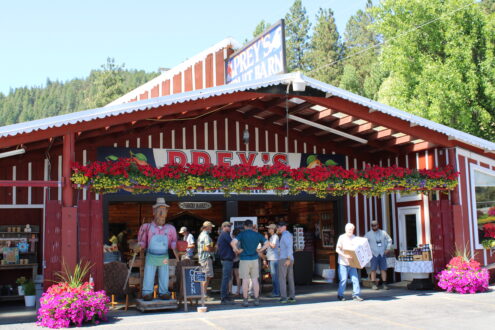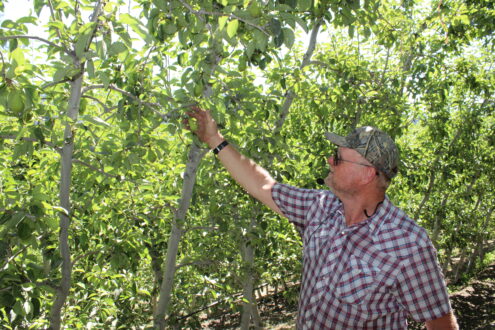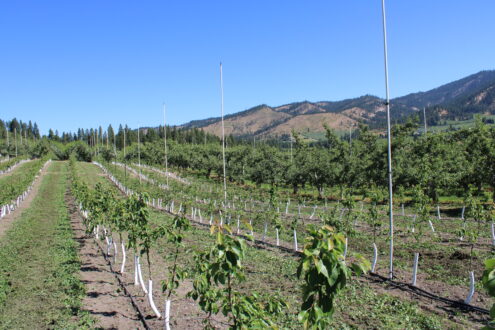

Apr 7, 2023High-altitude pears: Organics big part of Prey’s Fruit Barn & Orchards
Organics are important for Prey’s Fruit Barn & Orchards. For nearly half a century, the Wenatchee Valley farm has grown pears in elevations as high as 1,500 feet in Washington’s picturesque Cascade Mountains.
The valley’s warm days and cool nights shape pears better than other growing regions, said Rudy Prey Jr. The Leavenworth, Washington, orchardist grows green d’Anjous and green Bartletts, with smaller volumes of Boscs, red Starkrimsons, red Bartletts, red d’Anjous and Concords on 75 acres, two-thirds of which are organic.


Prey began growing pears organically in 1992. He entered the sector in a small way, planting only a handful of acres, but quickly expanded.
At the turn of the century, Prey grew all his pears organically. That lasted a couple of years.
“It became really difficult growing organically with the big, mature trees,” he said. “We had a hard time controlling insects. Production was going down.”
Prey converted those trees back to conventional growing methods.
Growing organics means limited access to acceptable inputs.
“There’s definitely a whole range of different products, some of which are very effective while some only work okay,” Prey said.
With those limitations, weed control remains the biggest issue, removing them mechanically or manually.
Uncertain organic future
Prey said he is debating whether he will continue growing organically.
“I’ve been on both sides of the spectrum,” he said. “As far as growing, I’ve had real success sometimes growing organically, sometimes not at all. It depends sometimes on the year. It can be difficult to keep your production as vigorous because you can’t use the same fertilizers as conventional. The cost of production is higher. We have had returns justify the costs.”
Mounting costs and the pear industry’s lack of clout to leverage crop protectants to battle insect pests, however, have become major problems pressing grower profitability, Prey said.
Because the comparatively small pear industry doesn’t garner much interest from crop protectant companies, growers are left with few options to battle pests and diseases.
In 1975, Prey’s family immigrated to the Wenatchee Valley from West Germany at the urging of relatives as part of a career change for Prey’s father, Rudy Sr., and began farming pears shortly after arrival. Rudy Sr. died in 2003 at 71 years of age.


In 1979, the Preys started a farm stand, adjacent to one of their older groves. The farm market sells apples, cherries, pears, peaches, nectarines, apricots and vegetables. Prey said one of the market’s benefits is growers can show consumers what to look for and the best ways to ripen pears purchased in supermarkets.
After attending Spokane Community College and the tree fruit production program at Wenatchee Valley College, the younger Prey decided he wanted to learn more about real world fruit production and worked at an Oregon nursery and a New Zealand orchard, where he handled many tasks.
High elevation challenges
When his father retired in 1996, Prey took over operations. Growing up in the family business during the late 1980s and 1990s, he purchased and leased his own orchards.
The experience in New Zealand, considered a leader in modern orchard production and techniques, convinced Prey his family’s pear orchards should go to a higher-density system, planting trees closer together for improved production and efficiency.
The varied topography at Prey’s Fruit Barn & Orchard makes farming more challenging. Pears prefer lower temperatures, however, and the elevation helps with production.
“It’s important every part of an orchard is as productive as it can be,” Prey said. “You can’t farm every part of an orchard the same. Instead of farming by the acre, you have to almost farm it by the tree.”
In recent years, Prey has worked to ensure all trees are similar to neighboring trees in terms of health and vigor.
Organic demand has been disappointing, he said.
“During the last several years, organic returns have been fairly low, while conventional returns have come up a little,” Prey said. “There’s not a big price difference anymore.”
Prey believes low grower returns will influence production.
“There will be less organic production going forward,” he said. “Some growers just can’t make it.”
Despite the disappointment, Prey loves his work.
“The best part of farming for me is working outdoors,” he said. “All through the year, growers have different jobs, not doing the same thing every day. You need to have an outside job. I wouldn’t be one to sit behind a desk all day.
“I live in a beautiful area, not like the Midwest where there are thousands of acres of flat ground,” Prey said. “There are many opportunities here. I also get to work in an area that’s also very nice to live.”
— Doug Ohlemeier, assistant editor
Top photo: Prey’s Fruit Barn grows green Bartletts, red and green d’Anjous, Boscs, red Starkrimsons, red Bartletts, red d’Anjous and Concords.
Photos: Doug Ohlemeier














